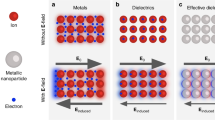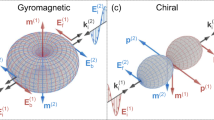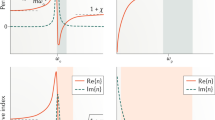Abstract
A great deal of attention has recently been focused on a new class of smart materials—so-called left-handed media—that exhibit highly unusual electromagnetic properties and promise new device applications1,2,3,4,5,6. Left-handed materials require negative permeability µ, an extreme condition that has so far been achieved only for frequencies in the microwave to terahertz range7,8,9,10,11. Extension of the approach described in ref. 7 to achieve the necessary high-frequency magnetic response in visible optics presents a formidable challenge12,13,14,15, as no material—natural or artificial—is known to exhibit any magnetism at these frequencies. Here we report a nanofabricated medium consisting of electromagnetically coupled pairs of gold dots with geometry carefully designed at a 10-nm level. The medium exhibits a strong magnetic response at visible-light frequencies, including a band with negative µ. The magnetism arises owing to the excitation of an antisymmetric plasmon resonance. The high-frequency permeability qualitatively reveals itself via optical impedance matching. Our results demonstrate the feasibility of engineering magnetism at visible frequencies and pave the way towards magnetic and left-handed components for visible optics.
This is a preview of subscription content, access via your institution
Access options
Subscribe to this journal
Receive 51 print issues and online access
$199.00 per year
only $3.90 per issue
Buy this article
- Purchase on Springer Link
- Instant access to full article PDF
Prices may be subject to local taxes which are calculated during checkout




Similar content being viewed by others
References
Veselago, V. G. The electrodynamics of substances with simultaneously negative values of permittivity and permeability. Sov. Phys. Usp. 10, 509–514 (1968)
Pendry, J. B. Negative refraction makes a perfect lens. Phys. Rev. Lett. 85, 3966–3969 (2000)
Shelby, R. A., Smith, D. R. & Schultz, S. Experimental verification of a negative index of refraction. Science 292, 77–79 (2001)
Smith, D. R., Padilla, W. J., Vier, D. C., Nemat-Nasser, S. C. & Schultz, S. Composite medium with simultaneously negative permeability and permittivity. Phys. Rev. Lett. 84, 4184–4187 (2000)
Pendry, J. B. Positively negative. Nature 423, 22–23 (2003)
Houck, A. A., Brock, J. B. & Chuang, I. L. Experimental observations of a left-handed material that obeys Snell's law. Phys. Rev. Lett. 90, 137401 (2003)
Pendry, J. B., Holden, A. J., Robbins, D. J. & Stewart, W. J. Magnetism from conductors and enhanced nonlinear phenomena. IEEE Trans. Microwave Theory Tech. 47, 2075–2084 (1999)
Wiltshire, M. C. K. et al. Microstructured magnetic materials for RF flux guides in magnetic resonance imaging. Science 291, 849–851 (2001)
Pendry, J. B. & O'Brien, S. Magnetic activity at infrared frequencies in structured photonic crystals. J. Phys. Condens. Matter 14, 6383–6394 (2002)
Yen, T. J. et al. Terahertz magnetic response from artificial materials. Science 303, 1494–1496 (2004)
Linden, S. et al. Magnetic response of metamaterials at 100 terahertz. Science 306, 1351–1353 (2004)
Landau, L. D. & Lifshitz, E. M. Electrodynamics of Continuous Media Section 60 (Oxford, Pergamon, 1960)
Dimmock, J. O. Losses in left-handed materials. Opt. Express 11, 2397–2402 (2003)
Panina, L. V., Grigorenko, A. N. & Makhnovskiy, D. P. Metal-dielectric medium with conducting nanoelements. Phys. Rev. B 66, 155411 (2002)
Podolskiy, V. A., Sarychev, A. K. & Shalaev, V. M. Plasmon modes in metal nanowires and left-handed materials. J. Nonlinear Opt. Phys. Mater. 11, 65–74 (2002)
Prokhorov, A. M. Molecular amplifier and generator for submillimeter waves. Zh. Eksp. Teor. Fiz. 34, 1658–1659 (1958)
Schawlow, A. L. & Townes, C. H. Infrared and optical masers. Phys. Rev. 112, 1940–1949 (1958)
Aizpurua, J. et al. Optical properties of gold nanorings. Phys. Rev. Lett. 90, 057401 (2003)
Jin, R. et al. Controlling anisotropic nanoparticle growth through plasmon excitation. Nature 425, 487–490 (2003)
Barron, L. D. Molecular Light Scattering and Optical Activity (Cambridge Univ. Press, Cambridge, UK, 1982)
Kottmann, J. P. & Martin, O. J. F. Plasmon resonant coupling in metallic nanowires. Opt. Express 8, 655–663 (2001)
Ebbesen, T. W., Lezec, H. J., Ghaemi, H. F., Thio, T. & Wolff, P. A. Plasmon-assisted transmission of entangled photons. Nature 391, 667–669 (1998)
Felidj, N. et al. Enhanced substrate-induced coupling in two-dimensional gold nanoparticle arrays. Phys. Rev. B 66, 245407 (2002)
Mock, J. J., Smith, D. R. & Schultz, S. Local refractive index dependence of plasmon resonance spectra from individual nanoparticles. Nano Lett. 3, 485–491 (2003)
Born, M. & Wolf, E. Principles of Optics Section 2.3 (Cambridge Univ. Press, Cambridge, UK, 1980)
Abeles, F. in Physics of Thin Films Vol. 6 (eds Francombe, M. H. & Hoffman, R. W.) Ch. V–VII (Academic, New York, 1971)
Gademann, A., Durkan, C. & Shvets, I. V. Optical impedance matching with near-field optical microscopy. J. Phys. D 36, 2193–2197 (2003)
Acknowledgements
This research was supported by EPSRC (UK). We thank L. Panina and D. Makhnovskiy for discussions, and N. Roberts for collaboration in experiments. A.A.F. acknowledges support from INTAS.
Author information
Authors and Affiliations
Corresponding author
Ethics declarations
Competing interests
Reprints and permissions information is available at npg.nature.com/reprintsandpermissions. The authors declare no competing financial interests.
Supplementary information
Supplementary Notes
This file contains a description of visible-light impedance matching observed in our experiments and a procedure of modelling of reflection spectra using Fresnel coefficients. Supplementary Figure 1 demonstrates the effect of impedance matching. Supplementary Figure 2 shows an agreement between the measured reflection spectra and the spectra calculated with the help of Fresnel coefficients. (PDF 331 kb)
Rights and permissions
About this article
Cite this article
Grigorenko, A., Geim, A., Gleeson, H. et al. Nanofabricated media with negative permeability at visible frequencies. Nature 438, 335–338 (2005). https://doi.org/10.1038/nature04242
Received:
Accepted:
Issue Date:
DOI: https://doi.org/10.1038/nature04242
This article is cited by
-
Design and optimization of broadband metamaterial absorber based on manganese for visible applications
Scientific Reports (2023)
-
Dual-band detection based on metamaterial sensor at terahertz frequency
Optical Review (2023)
-
A Metamaterial Inspired Low-Scattering Electric Quadrupole Antenna
Wireless Personal Communications (2023)
-
Observation of optical gyromagnetic properties in a magneto-plasmonic metamaterial
Nature Communications (2022)
-
Six band terahertz absorption in metamaterial for designing optical filters, and sensors
Optical and Quantum Electronics (2022)
Comments
By submitting a comment you agree to abide by our Terms and Community Guidelines. If you find something abusive or that does not comply with our terms or guidelines please flag it as inappropriate.



